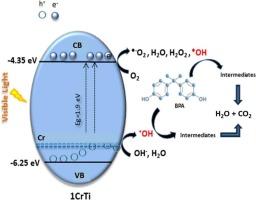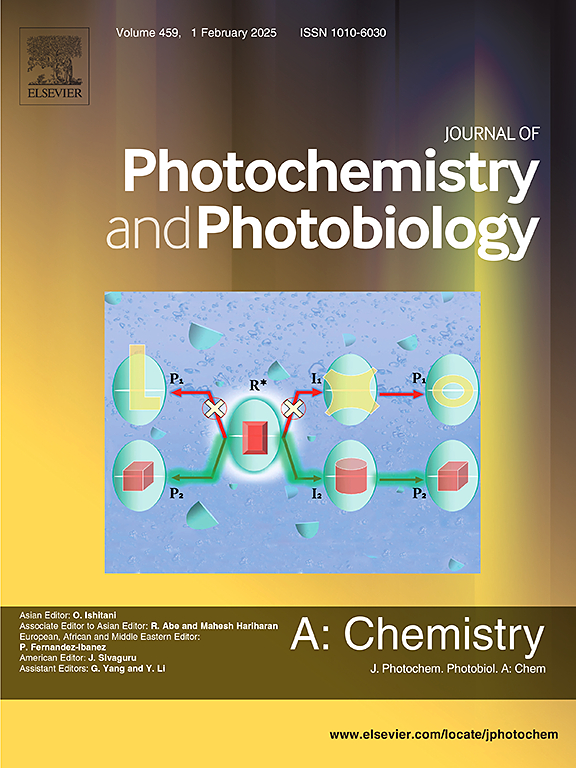Cr-TiO2 纳米粒子在可见光下增强双酚 A 的光催化降解能力
IF 4.1
3区 化学
Q2 CHEMISTRY, PHYSICAL
Journal of Photochemistry and Photobiology A-chemistry
Pub Date : 2024-10-10
DOI:10.1016/j.jphotochem.2024.116079
引用次数: 0
摘要
本研究采用溶胶-凝胶法合成了铬-二氧化钛纳米粒子,并在二氧化钛光催化剂中掺入了不同浓度的铬。评估了光催化剂在可见光(40 W,3000 lm,λ = 400-700 nm,在 450 和 545 nm 处有两个最大峰值)下降解双酚 A 的功效。对其进行了光学、形态和结构表征。与裸 TiO2 的 51.5% 降解率相比,掺杂了 1% Cr 的 TiO2 在 4 小时内显著降低了 99% 的双酚 A 降解率。这种增强作用可归因于纳米颗粒表面积增大、粒径减小以及半球形均匀形态所产生的协同效应。光致发光分析表明,铬离子的加入减缓了光生电子/空穴对之间的重组过程。XPS 和 Eg 数据有助于计算 VB 和 CB 值,表明光催化剂主要通过超氧化物(O2∙-)和羟基(HO∙)自由基氧化双酚 A 分子。本文章由计算机程序翻译,如有差异,请以英文原文为准。

Enhanced photocatalytic degradation of Bisphenol A under visible light by Cr-TiO2 nanoparticles
In this study, Cr-TiO2 nanoparticles were synthesized using the sol–gel method, with TiO2 photocatalyst doped varying Cr concentration. The photocatalysts were assessed for their efficacy in degrading Bisphenol-A under visible light (40 W, 3000 lm, and λ = 400–700 nm, with two maximum peaks at 450 and 545 nm). Optical, morphological, and structural characterization were conducted. TiO2 doped with 1 % Cr exhibited a remarkable 99 % reduction in BPA degradation within 4 h, compared to the 51.5 % degradation observed with bare TiO2. This enhancement can be attributed to synergistic effects arising from increased surface area, reduced particle size, and the semi-spherical, uniform morphology of the nanoparticles. Photoluminescence analysis revealed that Cr ion incorporation slowed the recombination processes between photogenerated electron/hole pairs. XPS and Eg data facilitated the calculation of VB and CB values, indicating that the photocatalysts predominantly oxidize the BPA molecule through superoxide () and hydroxyl () radicals.
求助全文
通过发布文献求助,成功后即可免费获取论文全文。
去求助
来源期刊
CiteScore
7.90
自引率
7.00%
发文量
580
审稿时长
48 days
期刊介绍:
JPPA publishes the results of fundamental studies on all aspects of chemical phenomena induced by interactions between light and molecules/matter of all kinds.
All systems capable of being described at the molecular or integrated multimolecular level are appropriate for the journal. This includes all molecular chemical species as well as biomolecular, supramolecular, polymer and other macromolecular systems, as well as solid state photochemistry. In addition, the journal publishes studies of semiconductor and other photoactive organic and inorganic materials, photocatalysis (organic, inorganic, supramolecular and superconductor).
The scope includes condensed and gas phase photochemistry, as well as synchrotron radiation chemistry. A broad range of processes and techniques in photochemistry are covered such as light induced energy, electron and proton transfer; nonlinear photochemical behavior; mechanistic investigation of photochemical reactions and identification of the products of photochemical reactions; quantum yield determinations and measurements of rate constants for primary and secondary photochemical processes; steady-state and time-resolved emission, ultrafast spectroscopic methods, single molecule spectroscopy, time resolved X-ray diffraction, luminescence microscopy, and scattering spectroscopy applied to photochemistry. Papers in emerging and applied areas such as luminescent sensors, electroluminescence, solar energy conversion, atmospheric photochemistry, environmental remediation, and related photocatalytic chemistry are also welcome.

 求助内容:
求助内容: 应助结果提醒方式:
应助结果提醒方式:


